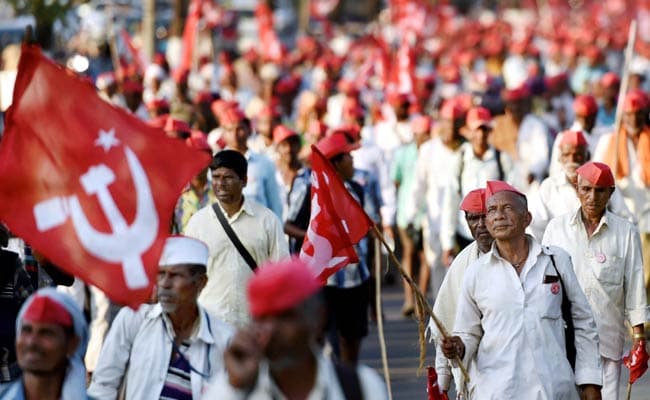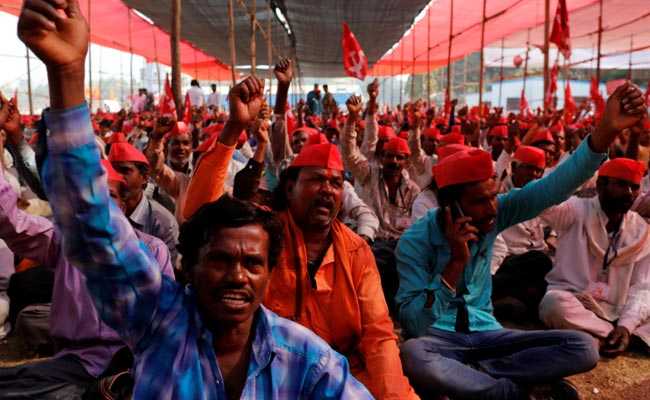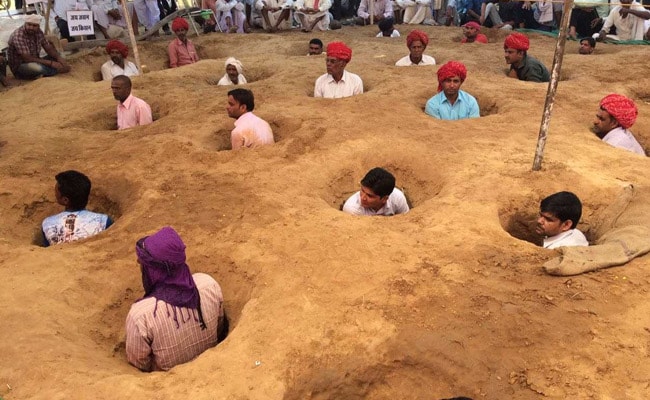My personal journey to explore the socio-economic core of an Indian village and refine my understanding of rural India took me to various parts of the Indian hinterland across the nation. Through my travels, I could sense that the existence of a village as an isolated socio-economic unit remains fragmented along delicate faultlines (as outlined in my recently launched book, "A Rural Manifesto"). Consider the case of Inder Singh, a marginal farmer near Orccha, in Tikamgarh district, amidst the Bundelkhand region of Madhya Pradesh. Near a picturesque landscape, surrounded by monuments built by the Bundela Rajputs, he faces destitution on an annual basis. Last year's rabi crop was destroyed before it could be harvested given intense heat and drought. His loans, covering seeds, fertilizers, crop protection chemicals and machinery lease, require restructuring. Another fallow year could drive him to abandonment.

Thousands of farmers marched around 180 kilometres - from Nashik to Mumbai in March this year
Adivasi farmers from the Santhal Pargana region in Jharkhand showcased to me how difficult it was to earn an income from farming. Many, on average, own about five acres of land, on half of which they cultivate green cowpea beans, while planting maize & bajra on the other half. With soil fertility poor and limited application of fertilizers, their crop yield is typically low - so much so that maize and bajra harvested is not enough to meet their household needs. Distress sales of their crops are quite common.
And so, I heard from agronomists, local civic institutions and thousands of upright and hardworking rural folk - whether it was camping in the deltaic regions of Uttarakhand, Vidarbha and Bundelkhand, or, more simply, meeting students of provincial universities in states often forgotten by national media, I was deluged with a range of studies and anecdotes, offering context and solutions alike. Somehow, we have forgotten the cause of marginal farmers, and their condition struck a chord for me. It was at once both an intellectual and emotional problem, and one with no easy solutions.

They demanded complete loan waiver, fair pay and transfer of adivasi land to farmers who have been tilling it for years
First, while grappling with the problem, we need to shift aside the cobwebs associated with thinking about the rural economy. We have been besotted by the idea of villages being self-sufficient and self-regulating for centuries. The idea that an Indian village was isolated and yet self-sufficient was first propounded by Charles Metcalfe in 1830 - "The village communities are little republics, having nearly everything that they want within themselves, and almost independent of any foreign relations. They seem to last where nothing else lasts. Dynasty after dynasty tumbles down; revolution succeeds to revolution; Hindoo. Pathan. Moghul. Mahratta. Sikh, English are all masters in turn, but the village communities remain the same." Karl Marx also popularized the idea of village self-sufficiency - "Under this form of municipal government, the inhabitants of the country have lived from time immemorial. The boundaries of the village have been but seldom altered, and though the villages themselves have been sometimes injured and even desolated by war, famine and disease, the same name, the same limits, the same interests, and even the same families have contributed for ages." Most writers of rural India have taken the idea of village autonomy and autarky for granted, categorizing the village as a standalone community with limited interactions with wider economic, political and religious systems. Our policy-makers have mostly failed to consider the deep dependence of our rural economy on the economics of marginal agriculture, especially in an era of fragmented landholdings and rising input and fuel prices. The result is rural discontent, with few opportunities (other than construction) to relieve the pressure.

Police use water cannons to disperse farmers protesting at Delhi-UP border (October, 2018)
Simple solutions like farm mechanisation, gloriously advocated during the Green Revolution and ever since, no longer seem to work as silver bullets. Ramesh Meena, hailing from a pastoral Adivasi tribe in Jhabua district in Madhya Pradesh, strains his brow when asked about mechanisation. His only experience has been one of leasing a tractor for a cropping season this year, for the princely sum of Rs 300. It certainly did cut down his time for tilling and weeding, helping him adjust quickly to variable rain showers this monsoon. Beyond that, he cares none for the range of equipment at the local custom hiring centre. Farm equipment for rental is usually unavailable; when offered, it is usually damaged.
More notable solutions like soil-testing are necessary, but suffer from limited awareness. Abhishek Vinnakota from Bagalkot district in Northern Karnataka casts a sweeping eye across his ancestral land, bemoaning its cracked open plains in the ongoing drought. His only recourse is to continue drilling for groundwater, while having his forehands take samples of soil to the district's soil-testing laboratory nearby. Insights from such tests have made a significant difference to his margins, with fertilizer spend declining by 30% and yields rising by 20%. The proper application of manure, urea and other enriched fertilizers has helped him survive. And yet, with a significant lack of awareness, most farmers in the district continue to plough their fields, applying manure and urea as they have done for eons, while remaining ignorant of the benefits of soil-testing. Urea, instead, reigns supreme.

More than 50 farmers dug pits and spent hours buried neck-deep in mud in a protest near Jaipur (October, 2017)
What became quickly evident in my journey was that policy-makers saw the problem in discrete sections - a minimum support price decline here, a rise in fertilizer prices over there; a study of the concomitant impact of changes in the agricultural economy was mostly missing. Ramesh Yadav, marginal farmer from Kaushambi district in Uttar Pradesh, has trouble sleeping - with just 0.2 acres of land, typically irrigated by tube-wells, he wonders about the fruits of his labour. He invested Rs 4,000 on seeds, fertilizers and pesticides in the last season for his maize crop - it was an arduous struggle to till the land with ploughing required several times to de-clump it. Requiring careful irrigation and weeding, the crop required several weeks of effort at cultivation. However, when the harvest period arrived, the prices of maize crashed - so much so that the cost of harvesting and transport to Kaushambi's outlying markets was not feasible. He and his family had to settle for harvesting for their own use, with some given to relatives and friends. The rest was left to rot. In the next cropping season, Ramesh tried to cultivate wheat - a crop that required hiring another labourer to help with tilling and harvesting. Given that he had spent a significant sum in purchasing fertilizer for his maize crop, he had to turn organic for wheat, tilling the land and harvesting the crop by hand. The harvest led to a marginal profit of just Rs 2,000, after including the cost of labour, land and other resources. Meanwhile, the marriage season had crept up and he had to take a loan of Rs 60,000 from the local moneylender to fund his daughter's marriage at a rate of 7.5% for the current year. He doesn't know when he will pay off the principal - his wife works as a daily agricultural labourer to help them make ends meet. This is the reality of agriculture in India. And we seek to mitigate it by offering ad hoc loan waivers.

Earlier this month, tens of thousands of farmers marched towards parliament demanding loan waivers and better prices for their produce.
We need a national conversation on rural distress. As with the decline of the peasant, so the interest of historians and social policy observers in capturing their fate - India's rich history has been illustrated with a range of tomes about kings, queens, nawabs and soldiers, and in some cases, even traders - and yet, the peasant itself, and the village economy he sustains has drawn limited attention. As Eric Stokes, the most famed of agrarian historians at Cambridge, recognized, "the balance of destiny in South Asia rests in peasant hands". The challenge, however, has been one of capturing the travails and tragedies of a social group that resists classification and leaves little, if any, records. The 1970s and 1980s saw renewed focus on empirical research that sought to provide a historical reconstruction of our agrarian economy, seeking correlations and dependencies on a range of social factors and social groups. In India, the history of land, especially in rural India, has somehow not gone together with the history of capital, subsuming documentation about changes in the rural economy under a dialectic between capitalist development and the proletarian masses. Unlike the Champaran Satyagraha, national attention has been curiously lacking. With empathy for India's marginal farmers, we must shift focus back to the rural economy.
(Feroze Varun Gandhi is a member of the BJP and a two-time member of parliament.)
Disclaimer: The opinions expressed within this article are the personal opinions of the author. The facts and opinions appearing in the article do not reflect the views of NDTV and NDTV does not assume any responsibility or liability for the same.


